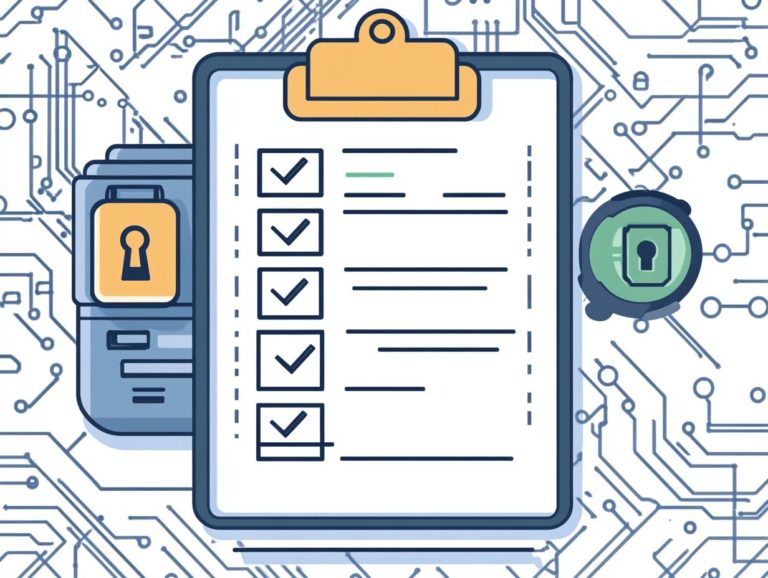how can i secure my cloud services?
In today s digital landscape, securing your cloud services is more critical than ever. Businesses rely heavily on cloud technology. It’s essential to understand the risks of inadequate security.
This article delves into common security threats, covering various attacks and vulnerabilities. It also offers best practices for protection. From using strong passwords to safeguarding your data through encryption, essential measures are outlined for public, private, and hybrid clouds.
You ll learn how to prepare for and respond to potential security breaches. This ensures your valuable data remains safe. Dive in to discover effective strategies for fortifying your cloud services.
Contents
- Key Takeaways:
- The Importance of Securing Cloud Services
- Common Security Threats to Cloud Services
- Best Practices for Securing Cloud Services
- Security Measures for Different Types of Cloud Services
- Ensuring Data Protection in the Cloud
- Encryption and Backup Strategies
- Preparing for and Responding to Security Breaches
Key Takeaways:
- Utilize strong passwords and access controls.
- Regularly update and patch your cloud systems.
- Implement encryption and backup strategies.
- Create a response plan in case of a security breach.
The Importance of Securing Cloud Services
Securing cloud services is essential in today’s digital landscape. Organizations are increasingly dependent on cloud infrastructure for data storage and processing, and knowing how to secure my social media accounts is also crucial for protecting sensitive information.
As cloud computing becomes more prevalent, it’s vital for businesses to prioritize cloud security. This safeguards sensitive information from unauthorized access and potential data breaches.
Implementing effective security measures and adhering to compliance requirements is key to mitigating risks. This not only ensures data integrity and availability but also fosters trust among your customers.
Understanding the shared responsibility model is key. This knowledge empowers you to implement strong security measures that align with cybersecurity standards and best practices.
Risks and Consequences of Inadequate Security
Inadequate security for cloud services can expose you to significant risks, including data breaches and unauthorized access to sensitive information.
These vulnerabilities can lead to devastating financial repercussions such as hefty fines and a loss of customer trust. The aftermath often includes lawsuits or regulatory scrutiny, further amplifying the damage.
Act now! Regular security assessments are vital to mitigate risks and protect your data. By identifying vulnerabilities and implementing robust risk management strategies, you can cultivate a secure environment that protects your data and your reputation.
Common Security Threats to Cloud Services

Cloud services confront a multitude of security threats that can compromise the integrity and confidentiality of your data. These threats include unauthorized access and a range of attack vectors designed to exploit vulnerabilities within the cloud infrastructure.
Types of Attacks and Vulnerabilities
Various types of attacks constantly target cloud services. They take advantage of vulnerabilities like weak authentication protocols and misconfigured security settings, which can lead to potential data breaches.
Among these threats, Distributed Denial of Service (DDoS) attacks bombard your cloud infrastructure with excessive traffic, making services unavailable. Meanwhile, SQL injection exploits vulnerabilities in your databases, allowing unauthorized access to sensitive data.
To tackle these risks effectively, it s wise to employ penetration testing. This method highlights weak spots in your security and helps you fix them before they are exploited.
Use intrusion detection systems for real-time monitoring. This alerts your team to any suspicious activities that might indicate a breach.
Should security incidents occur, having a robust disaster recovery plan in place is crucial for swiftly restoring operations and minimizing losses.
Best Practices for Securing Cloud Services
Implementing best practices for securing your cloud services is essential for protecting sensitive data. This is crucial for ensuring compliance with regulatory requirements in today s dynamic cybersecurity landscape.
This proactive approach strengthens your security and instills confidence in your stakeholders, allowing you to navigate the complexities of modern security challenges with assurance.
Implementing Strong Passwords and Access Controls

Establish strong passwords and robust access controls, including two-factor authentication, which adds an extra layer of security. This is essential to prevent unauthorized access to sensitive cloud resources.
This need becomes even more significant in today s digital landscape, where data breaches occur at an alarming rate. You must implement effective identity management systems to ensure that only authorized personnel can access critical information.
Security policies play a crucial role in reinforcing these measures, outlining how passwords are created, managed, and updated.
Consider companies like Microsoft, which have successfully reduced security incidents by enforcing mandatory password complexity and regular updates.
By adopting a layered security strategy, including role-based access control, you not only enhance your data protection efforts but also foster a culture of accountability among employees.
Regularly Updating and Patching Systems
Regularly updating your systems is a must for security! This essential measure addresses vulnerabilities and ensures compliance in cloud environments. As threats continue to evolve, relying on outdated software can expose your organization to significant risks.
Periodic vulnerability scans and comprehensive security audits are crucial in this process. They allow your team to identify and rectify weaknesses before they can be exploited. Keeping your software versions up to date not only bolsters your defenses but also aligns with industry standards and regulations.
This proactive approach to software management plays a vital role in effective risk management. Timely updates can mitigate potential breaches and build trust with clients and stakeholders who expect robust cybersecurity practices.
Security Measures for Different Types of Cloud Services
The security measures you adopt for various types of cloud services public, private, and hybrid differ substantially due to their distinct architectures and deployment models. Each type requires tailored strategies to effectively address its unique vulnerabilities and ensure robust protection.
Public, Private, and Hybrid Clouds

Each cloud deployment model public, private, and hybrid demands its own set of security protocols and compliance requirements to effectively mitigate risks. Understanding these distinctions is vital for protecting sensitive data and maintaining regulatory compliance.
For instance, in public cloud environments, shared resources can heighten threats, making robust encryption and stringent access controls essential. In contrast, private clouds often require stricter internal protocols to safeguard proprietary information; however, there s a risk of complacency if security assessments are neglected.
Hybrid models bring their own complexities, merging aspects of both public and private clouds. Therefore, it s crucial to regularly evaluate security measures to ensure they align with industry standards.
By proactively addressing these unique challenges, you can develop tailored strategies that not only safeguard your assets but also help you navigate the evolving landscape of regulations more effectively.
Ensuring Data Protection in the Cloud
Ensuring robust data protection in the cloud requires you to implement effective encryption and backup strategies. This approach maintains data integrity and guarantees availability, even when confronted with potential threats.
Encryption and Backup Strategies
Implementing effective encryption and backup strategies is essential for maintaining data integrity and ensuring that sensitive information is securely stored and easily recoverable.
Various encryption techniques, such as secret-key and public-key methods, are crucial for safeguarding your data from unauthorized access. Understanding which encryption method aligns best with your specific needs is vital.
Regular backups are crucial; they provide a safety net for restoring data in the event of hardware failures, cyberattacks, or other unexpected occurrences.
Organizations typically employ a range of backup strategies tailored to their operational requirements. Technical support is essential for maintaining these systems, helping to uphold robust security policies and ensuring that all data protection measures are effectively implemented and monitored.
Preparing for and Responding to Security Breaches
Preparing for and responding to security breaches is crucial for any organization aiming to minimize the impact of such incidents. By implementing well-defined incident response plans, you can ensure swift and effective recovery, safeguarding your operations and reputation.
Creating a Response Plan and Contingency Measures
Creating an effective incident response plan requires outlining contingency measures that empower your organization to respond promptly to security breaches and protect sensitive data.
Start by conducting thorough security audits. This step enables you to identify vulnerabilities and assess potential threats. Involving your technical support teams during this process ensures that the technical aspects of the plan align seamlessly with your organization’s overall security framework.
Establishing clear security policies is essential for your success! These guidelines shape the incident response and enhance preparedness throughout the organization. Ensuring every stakeholder understands their role significantly bolsters your ability to manage incidents swiftly and mitigate potential damage.
Frequently Asked Questions
What are some key steps to securing my cloud services? Some key steps include using strong passwords, enabling multi-factor authentication, regularly updating software and systems, and implementing access control measures. Additionally, you may want to consider how to secure your personal devices for added protection.
What is multi-factor authentication and how does it enhance cloud service security?
Multi-factor authentication is a security process that requires users to provide more than one form of identification, adding an extra layer of protection to access cloud services.
How can I ensure my data is encrypted and protected in the cloud?
To ensure data is encrypted and protected, use a reputable cloud service provider that offers encryption as a feature. Additionally, encrypt your data before storing it in the cloud using encryption software.
What are some best practices for securing my cloud services?
Best practices include regularly auditing user access and permissions, restricting access to sensitive data, and implementing a disaster recovery plan.
Act quickly if you suspect a security breach in your cloud services!
If you suspect a breach, immediately change all passwords and enable multi-factor authentication. Then, contact your cloud service provider to report the issue and follow their recommended steps for addressing the breach.
How often should I review and update my security measures for cloud services?
It is recommended to review and update security measures at least every six months. However, if there are major security threats or changes in your organization, review more frequently.
Take action today to fortify your security measures and protect your organization’s valuable data.






